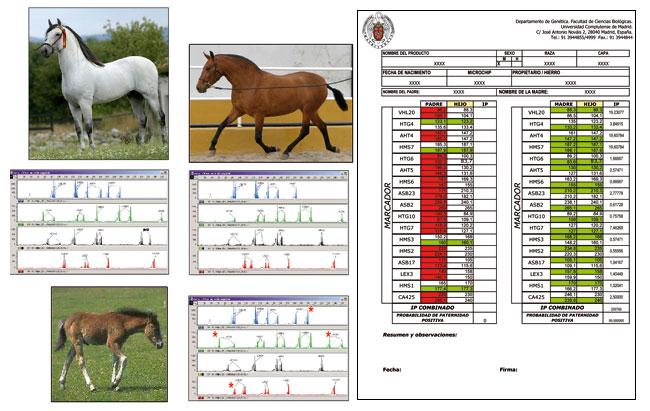INDIVIDUAL IDENTIFICATION AND CERTIFICATION OF PATERNITY IN HORSES AND OTHER EQUALS BY DNA MOLECULAR MARKERS
|
Description |
Royal Decrees 1133/2002 and 517/2005 indicate that pure-bred horses must be identified by genetic markers. The International Society of Animal Genetics (ISAG) has selected a panel of microsatellite markers for individual identification and paternity testing required for registration in the record books. The Equine Genetics group of the Faculty of Biology performs these analyzes from blood or hair samples, using 17 microsatellite markers that include those accepted by the ISAG plus nine other highly informative.
|
How does it work |
The technique is based on amplification of microsatellites using the PCR technique (Polymerase Chain Reaction), using specific primers for each of the 17 microsatellites used. This system is internationally standardized and is used by reference laboratories in horse genetics such as: Veterinary Genetics Laboratory. University of California, Davis; Institut National de la Recherche Agronomique. Laboratoire de Génietique Biochimique et de Cytogénétique de Jouy-en-Josas; Equine Parentage Testing and Research Laboratory. University of Kentucky, College of Agriculture; Australian Equine Genetics Research Center. University of Queensland.
Microsatellites are short (usually 2 to 4 base pairs) repeats in tandem, which do not transcribe and are randomly distributed throughout the genome. Being nuclear sequences, each individual has two copies of each marker, one of paternal origin and another of maternal origin, which can be the same or different from each other. The 17 microsatellite markers of the system used are very polymorphic - they have 5 to 22 variants each - so it is practically impossible to find two equal individuals, serving as an unequivocal identification. This identification is permanent throughout the life of the animal and independent of the type of biological sample used.
Identification by this method allows to perform paternity tests, comparing the genetic profiles of the subjects with those of their parents. This system is totally reliable for the exclusion of paternity and for the calculation of the probability of positive paternity.

Example of paternity analysis using microsatellites. The foal is incompatible with the father but compatible with the mother.
|
Advantages |
DNA markers have the advantage that results can be obtained from very small samples and are very easy to extract. On the other hand, this system does not generate indeterminacies because it directly accedes to the genotype of the individuals and, therefore, is not affected by the relations of dominance nor by the variations of penetrance or expressivity.
The collection of biological material is very simple following the instructions provided by our laboratory and does not require any chemical treatment or cooling in any of its steps.
The system used is the most modern and effective for genetic identification and verification of paternity and kinship and replaces the protein markers - proteins and blood groups - previously used. By using 17 highly polymorphic markers, it is practically impossible to find two individuals with the same genetic profile, so the reliability of the analysis is very high.
|
Where has it been developed |
This technology is developed in the Department of Genetics of the Faculty of Biological Sciences. The research group has experience in the development of molecular markers in different animal species.
|
And also |
What do we offer?
If so desired, the whole analysis process can be carried out in total confidentiality, since the laboratory only needs a key identifying each individual.
How to apply?
The owner, or interested organization, must collect the sample of blood or hair according to the instructions that will be sent from our laboratory. The collection of samples is performed by extremely simple methods that do not require refrigeration; the shipping is done simply by mail.
After analyzing the samples, the laboratory issues a report consisting of:
- 1. A technical report with the molecular profile of the individuals and details of the molecular protocol used.
- 2. A certification of the genetic identity of the individual, including the listing of its genetic variants for each of the 17 markers, as well as any observations considered relevant.
In the case of a paternity or kinship test, in addition to the genetic profiles of all the individuals analyzed, the report shall include a certificate of paternity or kinship indicating the compatibility or incompatibility of the parents or relatives with the subject.
|
Contact |
|
© Office for the Transfer of Research Results – UCM |
|
PDF Downloads |
|
Classification |
|
Responsible Researchers |
Pilar Arana: mparana@ucm.es
Alicia de la Peña: ali70060@ucm.es
Department: Genetics
Faculty: Biological Sciences


